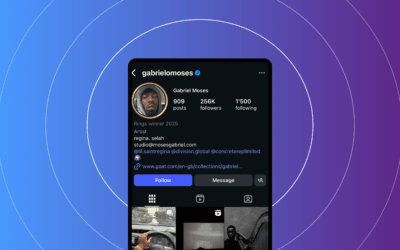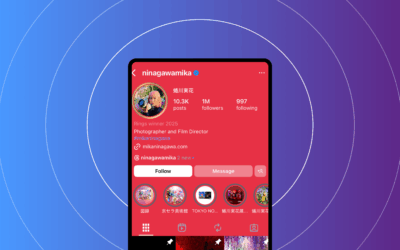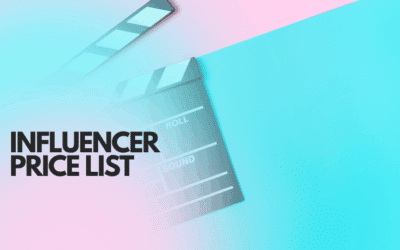Types d'influenceurs : Le guide du marketeur de 2025
Les types d'influenceurs déterminent la manière dont vous planifiez, évaluez et mesurez les partenariats avec les créateurs. Comprendre les types d'influenceurs aide les marques à faire correspondre les objectifs de leurs campagnes avec les forces des créateurs. Un influenceur est un créateur de contenu ou une personnalité publique dont les recommandations, le contenu ou la personnalité peuvent influencer les décisions d'achat ou de comportement d'un public spécifique en raison de l'autorité, de l'authenticité ou de la portée perçues. Ce guide présente la taxonomie de nano à méga, les différents types d'influenceurs par niche et les types d'influenceurs des médias sociaux par plateforme, ainsi que des modèles de collaboration, des points de référence, un cadre de sélection étape par étape et les risques.
De la nano à la méga : Taxonomie à plusieurs niveaux
- Nano-influenceurs : 1K-5K followers
Engagement : généralement 5-20% en raison de la proximité des communautés.
Idéal pour : les campagnes hyperlocales, la collecte d'UGC, les essais de produits authentiques, les communautés de niche.
Coût : souvent échange de produits à environ $50-$250 par article selon la niche et le format.
ICP : taux de sauvegarde, qualité des commentaires, utilisation des codes promo, conversions attribuées.
Source : Influencer Marketing Hub benchmark report - https://influencermarketinghub.com/influencer-marketing-benchmark-report/ (consulté en septembre 2025).
- Micro-influenceurs : 5K-50K followers
Engagement : environ 2-10% avec un fort ancrage communautaire.
Idéal pour : la sensibilisation ciblée, la défense des intérêts de la communauté, l'éducation verticale.
Coût : environ $100-$1,000 par article en fonction du créneau et des produits à livrer.
Indicateurs de performance : CTR, visites sur le profil, passages à l'histoire, échanges de codes.
Source : Influencer Marketing Hub benchmark report - https://influencermarketinghub.com/influencer-marketing-benchmark-report/ (consulté en septembre 2025).
- Influenceurs de niveau intermédiaire : 50K-250K followers
Engagement : environ 1-5%.
Le meilleur pour : l'expansion avec une autorité de niche ; un équilibre entre la portée et l'engagement.
Coût : environ $1,000-$10,000+ par poste.
ICP : impressions, sauvegardes, commentaires, temps de visionnage (YouTube), conversions assistées.
Source : Influencer Marketing Hub benchmark report - https://influencermarketinghub.com/influencer-marketing-benchmark-report/ (consulté en septembre 2025).
- Macro-influenceurs : 250K-1M followers
Engagement : environ 0,5-3%.
Idéal pour : une large notoriété, un potentiel viral, des lancements importants, des moments forts.
Coût : $10,000-$100,000+ par poste en fonction du canal et de l'offre.
Indicateurs clés de performance : portée, CPM, actions, impact de la recherche de marque.
Source : Influencer Marketing Hub benchmark report - https://influencermarketinghub.com/influencer-marketing-benchmark-report/ (consulté en septembre 2025).
- Méga-influenceurs / célébrités : 1M+ followers
Engagement : souvent inférieur à % mais portée absolue élevée.
Idéal pour : la notoriété de masse, le prestige de la marque, la vente au détail, les liens avec les célébrités.
Coût : $50,000-$1M+ en fonction de l'exclusivité et de la portée.
Mises en garde : coût élevé et risque d'authenticité ; la sécurité de la marque est nécessaire.
Source : Influencer Marketing Hub benchmark report - https://influencermarketinghub.com/influencer-marketing-benchmark-report/ (consulté en septembre 2025).
| Niveau de l'influenceur | Gamme des suiveurs | Engagement typique | Meilleur cas d'utilisation | Fourchette de coûts estimée |
|---|---|---|---|---|
| Nano | 1K-5K | 5-20% | Conversions de niche, UGC | $0-$250 |
| Micro | 5K-50K | 2-10% | Considération + conversion | $100-$1 000 |
| Niveau intermédiaire | 50K-250K | 1-5% | Considération évolutive | $1,000–$10,000+ |
| Macro | 250K-1M | 0,5-3% | Sensibilisation à grande échelle | $10,000–$100,000+ |
| Méga | 1M+ | Variable, inférieur % | Sensibilisation du public, prestige | $50,000-$1M+. |

Conseil : lorsque vous présélectionnez un créateur, vérifiez la taille de l'audience et les tendances à l'aide d'un outil externe avant de conclure un contrat. Voir Social Blade pour des vérifications rapides. Lame sociale.
Source : Social Blade : Social Blade - https://socialblade.com/ (consulté en septembre 2025).
Différents types d'influenceurs : par niche et catégorie de contenu
Le niveau décrit la portée. Le terme "type" désigne ici la niche ou le contenu vertical. Le mot-clé principal est important - les types d'influenceurs ne se limitent pas au nombre de followers, mais aussi à ce qu'ils créent et à qui ils s'adressent. Utilisez cette carte pour planifier vos campagnes.
- Style de vie et mode
Public : Chercheurs de style ; suiveurs de tendances (souvent des femmes de 18 à 34 ans).
Formats : Déballages, vidéos de stylisme, Histoires, bobines de vêtements ; codes et liens d'affiliation.
Idéal pour : Découverte et conversion ; gélules et cadeaux.
Questions de performance : CTR du Swipe-up, clics sur les étiquettes de produits, commentaires sur la taille et l'ajustement, utilisation du code. - Technologie et SaaS
Public : Professionnels curieux de technologie, décideurs en matière d'informatique, utilisateurs de produits à fort potentiel de croissance.
Formats : Présentation des fonctionnalités, didacticiels, vidéos de comparaison, co-animation de séminaires en ligne.
Idéal pour : Considération et activation ; formation à l'accueil.
Questions de performance : Inscriptions à l'essai, demandes de démonstrations, CTR UTM, levées de reciblage. - Beauté et bien-être
Public : Très engagé ; apprécie la transparence des ingrédients et les résultats.
Formats : Tutoriels, critiques, avant/après, histoires de la GRWM.
Idéal pour : Lancement de produits et cycles de réapprovisionnement ; génération d'UGC.
Questions sur les performances : Remboursements de codes, taux d'épargne/partage, volume d'examens. - Jeux et sports électroniques
Public : Communautés fidèles ; sessions longues ; valorisation de l'authenticité.
Formats : Flux en direct, clips, segments sponsorisés, intégration de matériel.
Idéal pour : L'engagement et les activations en jeu.
Questions relatives aux performances : Nombre de spectateurs simultanés, engagement sur le chat, clics sur les liens pendant les flux. - Voyage et alimentation
Public : Planificateurs et téléspectateurs ambitieux ; impact élevé sur la recherche et les réservations.
Formats : Blogs de longue haleine, bobines de destinations, fils d'itinéraires.
Idéal pour : Sensibilisation en haut du tunnel ; réservations mesurables via des codes/liens.
Demande de performance : Clics de recommandation, taux de sauvegarde, codes de réservation. - Finance, affaires et entrepreneuriat
Public : Professionnels, propriétaires de PME, étudiants ; faites confiance aux données et au contenu des études de cas.
Formats : Carrousels LinkedIn, long-form, webinaires, fils de discussion sur le leadership éclairé.
Idéal pour : Génération de leads, crédibilité, webinaires partenaires (B2B/SaaS).
Questions de performance : MQL, téléchargements de livres blancs, inscriptions à des séminaires en ligne. - Éducation et leadership éclairé
Public : Apprenants et praticiens ; substance et sources attendues.
Formats : Promotions de cours, explications, approfondissements sur YouTube, articles sur LinkedIn.
Idéal pour : Considération, formation, développement de la réussite des clients.
Questions de performance : Temps d'observation, inscriptions aux courriels, enquêtes post-événement.
Source : Later influencer marketing insights ; HubSpot influencer marketing guide ; conseils cités dans le plan (voir sources).
Types d'influenceurs des médias sociaux par plateforme
Le choix de la plateforme détermine le format et la portée. Les modes de découverte et d'engagement du public diffèrent, c'est pourquoi le type de créateur doit correspondre à l'endroit où se trouve votre public.
- Instagram (Reels, Stories, Posts)
Points forts : découverte visuelle, intégration des achats, étiquetage des produits, culture du remix.
Meilleurs niveaux : Micro-macro pour le commerce ; nano pour les programmes locaux ou à forte composante UGC.
Indicateurs clés : Sauvegardes, partages, téléchargements d'articles, clics sur les étiquettes de produits.
Remarque : les vidéos de courte durée (bobines) sont celles qui atteignent le plus grand nombre de personnes ; les tendances évoluent rapidement.
Source : Later format/trends guide - https://later.com/blog/influencer-marketing/ (consulté en septembre 2025).
- YouTube
Points forts : Didacticiels de longue durée, critiques de produits, durabilité de la recherche ; courts métrages pour la découverte.
Les meilleurs niveaux : Micro-mid-tier pour l'autorité de niche ; macro pour l'échelle et les tentpoles.
Indicateurs clés : Temps de visionnage, CTR, durée moyenne de visionnage, commentaires, croissance du nombre d'abonnés.
Note : Forte pour la considération et le référencement permanent. - TikTok
Points forts : formes courtes, viralité axée sur les tendances ; boucles de rétroaction rapides.
Meilleurs niveaux : Nano-micro pour tester les tendances ; passer à l'échelle moyenne/macro après avoir prouvé le bien-fondé du concept.
Indicateurs clés : Taux de lecture, partages, utilisation du son, performance des hashtags, sauvegardes.
Note : Les CPE légers et l'itération créative rapide conviennent aux essais.
Source : clickanalytic - when did TikTok come out (https://clickanalytic.com/when-did-tiktok-come-out) (consulté en septembre 2025).
- LinkedIn
Points forts : portée professionnelle, leadership éclairé, influence B2B, soutien ABM.
Les meilleurs niveaux : Les experts de niche et les créateurs natifs de LinkedIn qui publient des textes longs ou des carrousels.
Indicateurs clés : Clics sur les articles, vues sur les profils, téléchargements d'aimants à prospects. - Twitch / Streaming
Points forts : Engagement en direct, confiance de la communauté, démonstrations en temps réel et questions-réponses.
Les meilleurs niveaux : Streamers avec des communautés fidèles (jeux, matériel technique, outils pour créateurs).
Indicateurs clés : Nombre de visiteurs simultanés, durée moyenne de la session, croissance des sous-ensembles, performance des clips.
Source : HubSpot influencer marketing guidance ; Later format guide ; Nielsen trust studies (voir les références pour les liens)
Les modèles de collaboration et ce qu'ils impliquent pour chaque type de collaboration
- Campagnes axées sur les créateurs : La marque fournit un cahier des charges ; le créateur s'approprie l'exécution créative. Meilleur lorsque l'authenticité est importante. Mesures typiques : taux d'engagement, CTR, conversions. Le contrat doit définir les livrables, les divulgations et les droits d'utilisation.
- Campagnes gérées par la marque : La marque fournit les actifs/scripts ; plus de contrôle, moins d'authenticité. Travaille avec des entreprises de taille moyenne ou des macro-entreprises. Mesures : portée, CPM, augmentation de la recherche de marque. Contrat : approbations strictes, versions, fenêtres d'exclusivité.
- Programmes d'ambassadeurs de la marque : Partenariats continus avec un contenu répété et une éventuelle exclusivité. A travers le micro-mid-tier. Paramètres : levées de plusieurs postes, rétention de l'utilisation du code. Contrat : durée, cadence, exclusivité, droits de réutilisation.
- Affiliation et performance : Les créateurs perçoivent des commissions sur les conversions suivies (UTM, liens affiliés). Populaire auprès des nano/micro. Mesures : CPA/CPL, ROAS. Contrat : paiements, fenêtres de cookies, politique de fraude.
- Ensemencement et don de produits : Accès anticipé pour les mentions organiques ou les critiques. Populaire auprès des nano/micro ; certains intermédiaires pour les avant-premières. Mesures : messages gagnés, sentiment, volume d'UGC. Contrat : clause de divulgation claire.
- Co-création et collaboration en matière de produits : Produits communs ou lancements de marques conjointes. Généralement macro/mega. Mesures : ventes, liste d'attente, valeur des relations publiques. Contrat : propriété intellectuelle, partage des recettes, droits d'utilisation à long terme.
Source : Orientations de la FTC en matière d'information publicitaire ; références sectorielles citées dans le plan (voir références).
Avantages et inconvénients par type d'influenceur (résultats rapides)
- Nano : Avantages - grande authenticité ; faible coût. Inconvénients : échelle limitée. Meilleur KPI - conversions et utilisation du code.
- Micro : Avantages - portée ciblée ; rentable. Inconvénients : qualité variable de l'audience. Meilleur KPI - CTR et conversions.
- Niveau intermédiaire : Avantages - équilibre entre portée et pertinence. Inconvénients : coûts plus élevés, plus de contrats. Meilleur KPI - impressions et temps de visionnage.
- Macro : Avantages : large portée ; dynamique de lancement. Inconvénients : engagement plus faible par follower. Meilleur indicateur de performance : portée et impact sur la marque.
- Méga : Avantages - exposition massive ; prestige. Inconvénients : coût très élevé ; risque de retour sur investissement. Meilleur ICP - part de voix et valeur des relations publiques.
Source : Rapport de référence de l'Influencer Marketing Hub ; commentaires de l'industrie (voir références).
Comment choisir les types d'influenceurs pour votre campagne - cadre étape par étape
- Définir précisément l'objectif. Sensibilisation, engagement, considération, conversion ou fidélisation.
- Cartographier l'alignement du public. Valider les données démographiques, géographiques et les centres d'intérêt ; demander des kits médias.
- Sélectionnez les niveaux en fonction de l'objectif et du budget. Exemple : Sensibilisation = macro + mid-tier ; Conversion = micro + nano avec des modèles de performance.
- Fixer des fourchettes budgétaires et un plan d'échelle. Pilotez avec 10 à 20 micro-entreprises ou 2 à 4 entreprises de taille moyenne ; augmentez le nombre de micro-entreprises et d'entreprises de taille moyenne.
- Définir les mesures et l'attribution. Utilisez des UTM, des codes, des pages d'atterrissage dédiées, des tests d'attente.
- Lancer un projet pilote de 4 à 8 semaines, mesurer, répéter. Commencez avec 3 à 5 créateurs ; optimisez et déplacez le budget vers les plus performants.
Source : Page thématique sur le marketing d'influence de Statista ; guide de référence de l'Influencer Marketing Hub (références).
Données, critères de référence et brefs exemples de cas (axés sur le TEEE)
Cas A - Lancement d'un produit B2C : Une marque grand public s'est associée à 25 micro-influenceurs et à 3 créateurs de niveau intermédiaire. En six semaines, elle a constaté une augmentation de 18% de la recherche de marque et un taux de conversion de 2,3% sur une page d'atterrissage suivie. Ces résultats sont conformes aux fourchettes de performances typiques citées par les références du secteur.
Source : Influencer Marketing Hub benchmark report - https://influencermarketinghub.com/influencer-marketing-benchmark-report/ (consulté en septembre 2025).
Cas B - Inscription à des essais de SaaS : Une plateforme SaaS a engagé 4 leaders d'opinion de LinkedIn pour co-animer des webinaires et réutiliser des clips sur YouTube. Le programme a généré 1 200 MQL avec une conversion de 12% de la démo à l'essai, soutenue par un suivi UTM détaillé et un flux d'inscription dédié.
Source : HubSpot influencer marketing guide - https://blog.hubspot.com/marketing/influencer-marketing (consulté en septembre 2025).
Contexte du marché : Les spécialistes du marketing consacrent davantage de budgets aux créateurs ; eMarketer note une dynamique continue dans les économies des créateurs (https://www.emarketer.com/, consulté en septembre 2025). La confiance reste un facteur clé ; Nielsen fait état de la confiance dans les recommandations des créateurs lorsque les informations sont claires (https://www.nielsen.com/, consulté en septembre 2025).
Contexte du marché : L'avenir des types d'influenceurs en 2025
- Montée en puissance des micro- et nanoréseaux à longue traîne pour l'hyperciblage.
- Les places de marché de créateurs et l'achat programmatique pour accélérer la découverte.
- Des mesures d'authenticité et une évaluation de l'engagement vérifié voient le jour.
- Le renforcement de la réglementation des plateformes et de l'application des règles de divulgation accroît les besoins en matière de conformité.
- Croissance des influenceurs B2B sur LinkedIn pour les démonstrations et le co-marketing.
- Découverte et prévisions assistées par l'IA, avec des mises en garde sur le contenu synthétique et les informations à fournir.
Sources : Influencer Marketing Hub ; eMarketer ; Nielsen (références listées dans la section Ressources).

Ressources et références (EEAT)
- Influencer Marketing Hub - benchmarks et tarifs : https://influencermarketinghub.com/influencer-marketing-benchmark-report/ (consulté en septembre 2025)
- Statista - taille du marché et tendances des dépenses : https://www.statista.com/topics/2706/influencer-marketing/ (consulté en septembre 2025)
- eMarketer - dépenses publicitaires et tendances de l'économie des créateurs : https://www.emarketer.com/ (consulté en septembre 2025)
- FTC - disclosure & compliance : https://www.ftc.gov/news-events/media-resources/truth-advertising/advertising-disclosures (consulté en septembre 2025)
- Social Blade - vérification du créateur/canal : https://socialblade.com/ (consulté en septembre 2025)
- Later - platform behavior and format guidance : https://later.com/blog/influencer-marketing/ (consulté en septembre 2025)
- Nielsen - études de confiance/impact : https://www.nielsen.com/ (consulté en septembre 2025)
- HubSpot - Influence marketing best practices : https://blog.hubspot.com/marketing/influencer-marketing (consulté en septembre 2025)
FAQ
Q : Que sont les nano-influenceurs ?
R : Les nano-influenceurs ont entre 1 000 et 5 000 followers et affichent souvent un engagement de 5 à 20% grâce à des communautés étroites. Ils sont parfaits pour les essais de produits authentiques, les conversions de niche et l'UGC. Mesurez les échanges de codes, les sauvegardes et la qualité des commentaires pour évaluer l'impact.
Q : Comment classez-vous les influenceurs ?
R : Utilisez un objectif en trois parties : niveau (nano→mega), niche (par exemple, beauté, technologie, finance) et plateforme (Instagram, YouTube, TikTok, LinkedIn, Twitch). Vérifiez les données démographiques de l'audience, le taux d'engagement, l'adéquation du contenu et les résultats antérieurs pour trouver la bonne combinaison.
Q : Quelle est la différence entre les micro-influenceurs et les macro-influenceurs ?
R : Micro (5K-50K) offre souvent un engagement plus fort et une pertinence de niche à moindre coût, avec une plus grande liberté créative. Macro (250K-1M) offre une plus grande portée et une dynamique de lancement, mais avec un coût plus élevé et parfois un engagement plus faible par follower.
Q : Comment les influenceurs peuvent-ils influer sur le retour sur investissement du marketing ?
R : La portée et la confiance mènent à l'action. Utilisez des codes promotionnels, des UTM, des pages d'atterrissage dédiées et des lift tests pour quantifier l'impact. Les points de référence varient selon le niveau ; consultez les études sectorielles établies.
Q : Les marques de SaaS doivent-elles travailler avec des influenceurs ?
R : Oui. Pour le SaaS, l'éducation et la confiance l'emportent. Associez-vous à des leaders d'opinion de LinkedIn et à des YouTubers de niveau moyen pour des démonstrations et des webinaires. Suivez les MQL, les inscriptions à l'essai et le CPL pour évaluer l'impact.
Q : Comment mesurez-vous la qualité et l'adéquation de l'influenceur ?
R : Vérifiez l'alignement de l'audience (géographie, rôle, intérêts), la qualité de l'engagement et la pertinence du contenu. Demandez des analyses et l'historique des performances, puis validez avec des vérifications tierces.
Q : Quels sont les risques et les mesures d'atténuation les plus courants en matière de marketing d'influence ?
R : La sécurité de la marque, la fraude et le non-respect des obligations d'information sont les principaux risques. Il convient d'atténuer ces risques par des contrats clairs, des vérifications, des audits et des divulgations obligatoires conformément aux règles de la FTC.
Glossaire
- Nano-influenceur - 1K-5K followers ; public de niche très engagé.
- Micro-influenceur - 5K-50K followers ; autorité de niche + résultats mesurables.
- Influenceur de niveau intermédiaire - 50K-250K ; autorité de niche évolutive.
- Macro-influenceur - 250K-1M ; large portée avec un créateur professionnel.
- Méga-influenceur - 1M+ ; portée de la célébrité.
- UGC - contenu généré par les utilisateurs et produit par des créateurs ou des clients.
- Divulgation de la FTC - Transparence requise pour les parrainages ; voir le lien de la FTC dans la section Ressources.
Lancer un projet pilote à faible risque
Choisissez un niveau, deux créateurs et un objectif mesurable. Téléchargez la liste de contrôle de la stratégie d'influence et réservez un appel stratégique de 15 minutes si vous avez besoin d'aide pour sélectionner les créateurs ou définir les indicateurs clés de performance.
Conclusion
Les types d'influenceurs que vous choisissez doivent correspondre à vos objectifs, à votre public et à votre format créatif, et pas seulement au nombre de followers. Utilisez des niveaux pour définir les budgets et l'échelle, des niches pour garantir la pertinence et des plateformes pour façonner l'histoire. Avec un briefing clair, un suivi rigoureux et les bons créateurs, les campagnes 2025 peuvent générer à la fois confiance et croissance. Le mot-clé principal - les types d'influenceurs - reste au cœur de la planification, de la mesure et de la santé à long terme du programme.
Pour plus de conseils pratiques, voir notre Découverte d'influenceurs ou explorer Mesurer le retour sur investissement des influenceurs pour lier les dépenses aux résultats. Utiliser le Liste de contrôle pour la planification de la campagne pour structurer les dossiers, les approbations et les actifs. Si vous êtes curieux d'en savoir plus sur les micro-influenceurs de niche, lisez Qu'est-ce qu'un micro-influenceur ?.
Les études de cas et les critères de référence s'alignent sur les rapports de l'industrie tels que le Rapport de référence sur le marketing d'influence et le guide de l'influenceur HubSpot.
Articles sur le marketing d'influence
Des conseils pratiques pour mieux réussir ses campagnes de marketing d'influence
Qui est Gabriel Moses ?
Découvrez Gabriel Moses, l'artiste né à Londres qui mêle mode, musique et patrimoine dans des récits visuels saisissants. De Dior à Johnnie Walker, voyez pourquoi il façonne la culture.
Qui est Mika Ninagawa ?
Découvrez Mika Ninagawa, photographe et réalisatrice visionnaire de Tokyo célébrée pour son art vif, ses récits audacieux, et gagnez à Instagram Rings 2025.
Liste de prix des influenceurs : Ce que les marques paieront en 2025 et 2026
Une liste de prix pour les influenceurs est un ensemble de tarifs et de conditions que les créateurs (ou leurs agents) fournissent - la base pour budgétiser, négocier et prévoir les campagnes d'influence.






